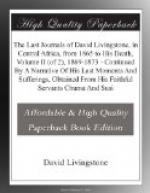20th March, 1871.—I am heartsore, and sick of human blood.
21st March, 1871.—Kasongo’s brother’s child died, and he asked me to remain to-day while he buried the dead, and he would give me a guide to-morrow; being rainy I stop willingly. Dugumbe is said to purpose going down the river to Kanagumbe River to build on the land Kanagumbe, which is a loop formed by the river, and is large. He is believed to possess great power of divination, even of killing unfaithful women.
22nd March, 1871.—I am detained another day by the sickness of one of the party. Very cold rain yesterday from the north-west. I hope to go to-morrow towards the Lakoni, or great market of this region.
23rd March, 1871.—Left Kasongo, who gave me a goat and a guide. The country is gently undulating, showing green slopes fringed with wood, with grass from four to six feet. We reached Katenga’s, about five miles off. There are many villages, and people passed us carrying loads of provisions, and cassava, from the chitoka or market.
24th March, 1871.—Great rain in the night and morning, and sickness of the men prevented our march.
25th March, 1871.—Went to Mazimwe, 7-1/2 miles off.
26th March, 1871.—Went four miles and crossed the Kabwimaji; then a mile beyond Kahembai, which flows into the Kunda, and it into the Lualaba; the country is open, and low hills appear in the north. We met a party from the traders at Kasenga, chiefly Matereka’s people under Salem and Syde bin Sultan; they had eighty-two captives, and say they fought ten days to secure them and two of the Malongwana, and two of the Banyamwezi. They had about twenty tusks, and carried one of their men who broke his leg in fighting; we shall be safe only when past the bloodshed and murder.
27th March, 1871.—We went along a ridge of land overhanging a fine valley of denudation, with well-cultivated hills in the distance (N.), where Hassani’s feat of bloodshed was performed. There are many villages on the ridge, some rather tumbledown ones, which always indicate some misrule. Our march was about seven miles. A headman who went with us plagued another chief to give me a goat; I refused to take what was not given willingly, but the slaves secured it; and I threatened our companion, Kama, with dismissal from our party if he became a tool in slave hands. The arum is common.
28th March, 1871.—The Banian slaves are again trying compulsion—I don’t know what for. They refused to take their bead rations, and made Chakanga spokesman: I could not listen to it, as he has been concocting a mutiny against me. It is excessively trying, and so many difficulties have been put in my way I doubt whether the Divine favour and will is on my side.
We came six miles to-day, crossing many rivulets running to the Kunda, which also we crossed in a canoe; it is almost thirty yards wide and deep: afterwards, near the village where we slept, we crossed the Luja about twenty yards wide, going into the Kunda and Lualaba. I am greatly distressed because there is no law here; they probably mean to create a disturbance at Abed’s place, to which we are near: the Lord look on it.




